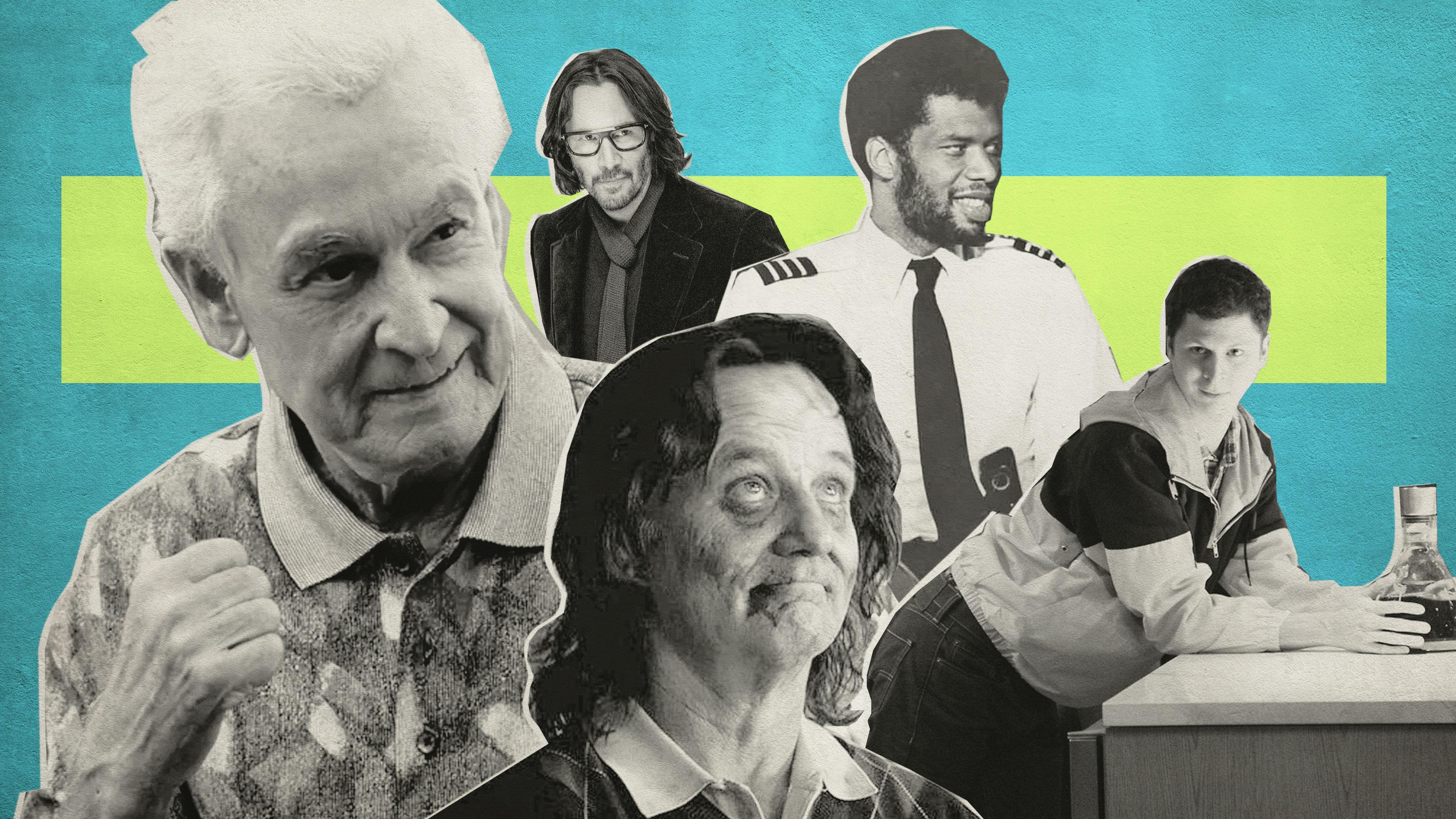
About three-quarters of the way into Netflix’s Always Be My Maybe, Keanu Reeves appears (to the sound of AWOLNATION’s “Sail”) as a heightened version of himself, elevating a perfectly good rom-com into one of the streamer’s most enjoyable original films to date. There is, of course, a rich history of famous people playing themselves in a movie for comedic effect—and though Keanu’s turn is deliriously delightful, there are many actors challenging for the title of who did this trope best.
Bill Murray in Zombieland
Michael Baumann: Future generations will judge us for the semi-ironic American zombie hysteria of the early 2000s, a distinct if deeply weird period bookended on one end by Max Brooks’s 2003 The Zombie Survival Guide and on the other by the 2016 box office bomb Pride and Prejudice and Zombies. (That not one but two Walking Dead programs persist in 2019 is just another smirking zombie joke, and not a rejection of this timeline.)
One of this period’s totemic works of fiction is 2009’s Zombieland, which more than any other book or film captures the winking silliness of the whole genre. It is beautifully simple, with just six speaking parts, five of them played by actors who had been or would go on to be nominated for an Oscar. But of these, Murray’s cameo as himself is most memorable. Like zombies, the latter-day Murray is a curio of a certain time period, popular among people whom normies would call hipsters, and whom real hipsters would call normies. If a zombie apocalypse happened, of course Murray would traipse around his mansion in makeup and welcome visitors, and of course the real-life Murray would be down to portray himself that way in a movie. Such is the weirdness, and weird thirstiness, of the post–Lost in Translation Bill Murray.
Michael Cera in This Is the End
Alan Siegel: The entire cast of Seth Rogen and Evan Goldberg’s apocalyptic comedy plays heightened or twisted versions of themselves, but no one goes to the same shockingly hilarious extreme as Cera. (And yes that includes Danny McBride, who by the movie’s climactic scene becomes a cannibal.) During his brief time on screen, the sweet, meek young man from Arrested Development, Juno, and Superbad—as Mindy Kaling puts it: “Pale, 110 pounds, hairless”—is revealed to be a coked-up scumbag. After doing a line, he smacks Rihanna’s ass. She responds, righteously, by thunderously slapping him in the face. “We did it like six times,” Rogen told reporters in 2013, “and the last time he was like, ‘I don’t think I can do this anymore.’” After that, fake Cera blows a cloud of cocaine in former costar Christopher Mintz-Plasse’s face. Then Jay Baruchel walks in on Cera in the bathroom, flanked by two women, pantsless.
Alas, Evil Michael Cera is short-lived. When hell literally breaks loose, a jagged lamp post swings down and impales him in through the back, killing the wicked new persona for good.
DMX in Top Five
Alison Herman: Top Five is not a movie that bothers to construct much of a fourth wall. Chris Rock’s best self-made vehicle—all due respect to Head of State—casts Rock as a superstar comedian trying to figure out his late career amid a rocky personal life; it’s not exactly a stretch. Late in the movie, though, Rock dispenses with what little pretense he had to begin with and unleashes the most high-impact cameo in a movie designed to deliver them:
Jerry Seinfeld, Taraji P. Henson, Tracy Morgan, and Whoopi Goldberg are all well and good. DMX, however, announces himself by growling, then cocking his head like a curious dog, then launching into a god-awful rendition of Charlie Chaplin’s “Smile,” because this fictional version of him really just wants to sing. When Rock’s character speaks for all of us and asks the rapper what he’s doing in a random Manhattan jail cell, he spits back: “What am I doing here? I’m X, man. I live in this motherfucker. Don’t you watch the news?” The performance is self-aware, as is par for the course in these kinds of appearances, but also absurd and genuinely funny. Top Five is about comics talking shop, but X quickly proves he can hang with the pros.
Kareem Abdul-Jabbar in Airplane!
Rob Harvilla: “Wait a minute, I know you!” exclaims the smart-ass kid in the cockpit. “You’re Kareem Abdul-Jabbar!” That a 7-foot-2, six-time NBA MVP is serving as copilot might not crack the top-20 wackiest things about Airplane!, but there he is, with the unconvincing alias “Roger Murdock,” breaking his cover only when the kid starts sassing him: “My dad says you don’t work hard enough on defense.” Kareem grabs the kid by the shirt, pulls him close, and delivers the 1980 equivalent of “Im trying Jennifer.” Quote: “Listen, kid, I’ve been hearing that crap ever since I was at UCLA. I’m out there busting my buns every night. Tell your old man to drag Walton and Lanier up and down the court for 48 minutes.” Soon, when he, too, succumbs to food poisoning—don’t eat the fish—we learn that Kareem is suited up for game time from the waist down. That’s why he’s the greatest.
David Hasselhoff in The SpongeBob SquarePants Movie
Mose Bergmann: In the early age of the internet, the memes were simpler. For whatever reason, one of the more popular subgenres of the art form was ’80s TV. We had the G.I. Joe PSAs, He-Man memes, and all that Chuck Norris stuff. And we had David Hasselhoff. Remember Hasselhoff? He was in that show where he talked to a car, and that show with a bunch of hunky lifeguards solving beach crimes. He also released an album that went triple platinum in Europe. What a guy. Just go through his Wiki page and you’ll see that his career itself is a bit of a meme, and it reached its peak with his meta appearance in The SpongeBob SquarePants Movie.
Nearing the climax of the movie, Hasselhoff appears as the deus ex machina, materializing on the beach in classic slow-mo when all hope seems lost. “I’m David Hasselhoff,” he simply and confidently responds when SpongeBob and Patrick ask who he is. He offers our heroes a ride to Bikini Bottom. They hop onto Hasselhoff’s back and he swims into the heart of the ocean at such a speed he is lifted above the water like a speedboat. For cinema, the scene is truly a landmark moment. For Hasselhoff, it’s truly special because it takes the existing legend of the Hoff, basically the Poseidon of the small screen, and turns it up to 100. It’s a passing-of-the-torch moment, a pseudo blessing from the former king of aquatic TV to his new cartoon counterpart. It’s utterly beautiful.
Eminem in Funny People
Donnie Kwak: In most Judd Apatow films, the characters are rough facsimiles of the people who play them. Thus, in Funny People we have Adam Sandler as a washed movie-star comedian, and Seth Rogen as an upstart who aspires to become one. Then, there’s Eminem, as Eminem. “You’re stuck, just like me,” says Slim Shady to Sandler’s George Simmons. George is celebrating his miracle recovery from leukemia, but Em wonders whether death might be better than living in the celeb fishbowl. “Can’t go to fucking Chuck E. Cheese. I can’t go to Target. I can’t go to Best Buy,” the rapper vents beneath his backward Air Jordan hat. “I can’t go to fucking Walmart, Kmart—you fucking name it, I can’t go there.”
The diatribe explains why the real-life Em was so bitter and withdrawn in the post–8 Mile mid-aughts. Famous, but at what cost? Whatever the price of Ray Romano’s creepy, unwanted attention is, I guess.
The Poker Table in Ocean’s Eleven
Andrew Gruttadaro: Inherently, Ocean’s Eleven is partly about the sheer power of celebrities, and the spectacle of putting a bunch of them in a room together. The scene at the beginning of the movie in which Rusty (Brad Pitt) teaches a bunch of hot young actors how to play poker, then, is a joke within a joke. Situated at Rusty’s backroom table is Topher Grace, Joshua Jackson, Shane West, Barry Watson, and Holly Marie Combs; their most notable titles at the time, respectively: That ’70s Show, Dawson’s Creek, Once and Again, 7th Heaven, Charmed. These are pillars of teen magazines, actors on the brink of superstardom who by all accounts we ought to be taking seriously. And yet here they are in Ocean’s Eleven, playing a bunch of idiots who can’t tell blackjack from five-card stud, and who are trying to gain a modicum of coolness by paying a much cooler person—essentially, Brad Pitt—to teach them a cool skill. Not only is it deeply funny—Rusty forcing Barry Watson to fold and telling him “You’re done” is the stuff of legend—it’s also deeply clever.
Halsey in A Star Is Born
Lindsay Zoladz: Why is Halsey in A Star Is Born? It’s a modern mystery of cinema that has puzzled film scholars for months, if not almost an entire year. Much of the ASIBCU seems to exist on an alternate plane of reality in which imaginary pop stars like Jackson Maine and Ally Campana are household names and in which—according to one very convincing theory from the mind of comedian Cait Raft—9/11 never happened. But then toward the end of the film, when Ally receives the Grammy for Best New Artist, it is presented to her by … Halsey, a pop star who, incidentally, has never won a Grammy, but is currently famous in the version of reality we recognize to be our own.
Halsey’s cameo might have passed by without incident—had she not spent her roughly eight seconds of screen time acting her aching heart out. The notes of this performance are to be savored like wine: Halsey leans into the microphone, which is for some reason about a foot too short for her. (Award shows, amirite?!) “And the winner is …” says Halsey. She stands back up to her full, dignified height to open the envelope. And then there is a long, pregnant pause in which Halsey knows something we don’t—and she’s delighted by it. Halsey laughs to herself, earrings jangling as her head shakes in joyous disbelief. “How great,” she says, as though she knew it all along. Then, she tells the world: “ALLY!” How great, Halsey. How great indeed.
Bob Barker in Happy Gilmore
Megan Schuster: In the year of our lord 1996, we were gifted with possibly the most iconic moment in film history: Bob Barker saying “bitch” on camera.
Barker’s hands-throwing cameo in Happy Gilmore is exceptional for a few reasons, namely because of how utterly shocking it is to watch the normally mild-mannered Price Is Right host turn heel the second Adam Sandler’s Happy Gilmore (his partner in a pro-am golf tournament) starts to succumb to a heckler. Barker tosses his hands up in frustration, gives “encouraging speeches” that come across like thinly veiled jabs, and eventually tells Happy, “I can’t believe you’re a professional golfer—I think you should be working at the snack bar.” Also: He does all that while wearing a shirt that resembles the tragic fits of the 1999 U.S. Ryder Cup team. Perhaps the best part of all, though, was Barker’s revelation years later that, not only did he film his own fight sequences (!!!), he also signed on for the project only after he was assured that he’d win the fight.
Happy Gilmore taught its viewers a few lessons: Don’t meet anyone at the ninth green of a golf course at 9 p.m.; alligator heads are not an appropriate gift under any circumstances; Zambonis can be romantic if you really try; and most importantly, never try to fight Bob Barker.

